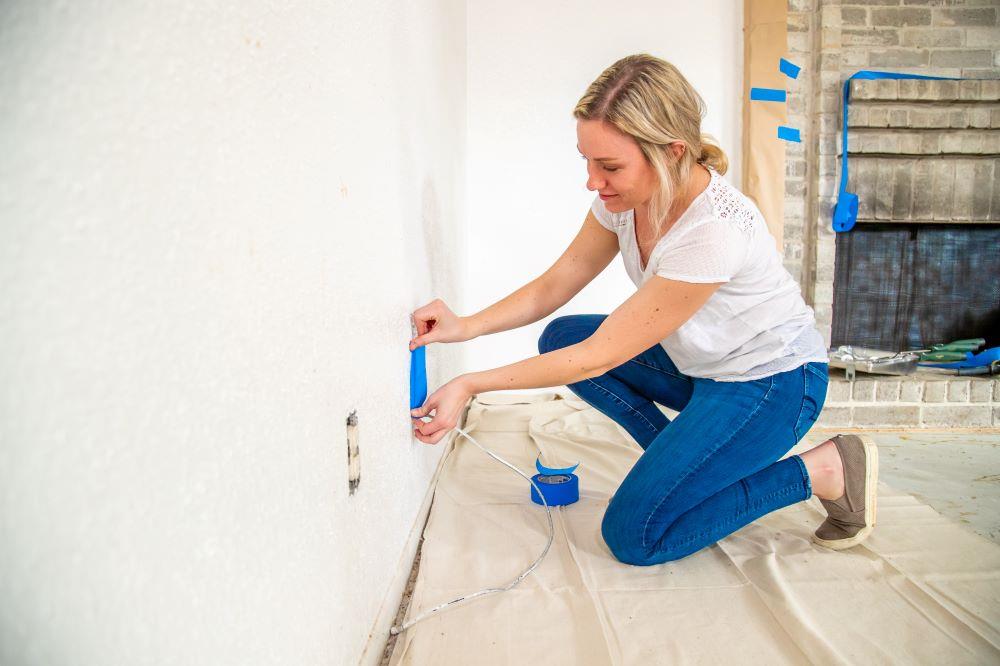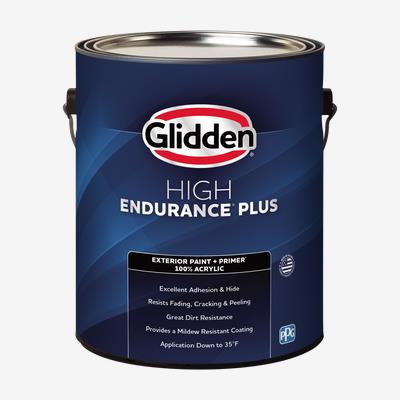Glidden® High Endurance® Plus Exterior Paint + Primer
Size
Gallon/3.78 L (01), 5 Gallons/18.9 L (05), Drum/200 L (55), Quart/946 mL (04)
Sheen
Flat, Satin, Semi Gloss, Semi gloss

Product Details
Glidden® High Endurance® Plus Exterior is a 100% acrylic paint and primer* in one that provides mildew resistance, excellent adhesion and hide, great dirt resistance, and resists fading, cracking and peeling. Made in the USA of globally sourced materials.
Features:
- This exterior paint and primer also resists fading, cracking & peeling
- Great dirt resistance
- Excellent hide & adhesion
- Provides a mildew resistant coating
*Separate primer or multiple coats may be required.
© AkzoNobel, revisions © 2022 PPG Industries, Inc. All Rights Reserved. The PPG Logo is a registered trademark of PPG Industries Ohio, Inc. The Glidden Logo is a registered trademark of PPG Architectural Finishes, Inc. Endurance and High Endurance are registered trademarks of AkzoNobel.
Looking for a datasheet? Access PPG's full datasheet portal here or visit https://products.ppgac.com/
| Code | Finish | Base | Sizes | Download |
| 9001G | Flat | White & Pastel Base | Gallon/3.78 L (01) | |
| 9001G | Flat | Light Base | 5 Gallons/18.9 L (05) | |
| 9001GP | Flat | White & Pastel Base | Gallon/3.78 L (01) | |
| 9002G | Flat | Midtone/Intermediate Base | Gallon/3.78 L (01) | |
| 9002GP | Flat | Midtone/Intermediate Base | Gallon/3.78 L (01) | |
| 9003G | Flat | Neutral/Ultradeep/Accent/Clear | Gallon/3.78 L (01) | |
| 9003GP | Flat | Neutral/Ultradeep/Accent/Clear | Gallon/3.78 L (01) | |
| 9200G | Satin | White & Pastel Base | Gallon/3.78 L (01) | |
| 9201G | Satin | Light Base | 5 Gallons/18.9 L (05) | |
| 9201G | Satin | LIGHT BASE | Drum/200 L (55) | |
| 9201GP | Satin | White & Pastel Base | Gallon/3.78 L (01) | |
| 9201GP | Satin | WHITE & PASTEL BASE | Quart/946 mL (04) | |
| 9202G | Satin | Midtone/Intermediate Base | Gallon/3.78 L (01) | |
| 9202GP | Satin | Midtone/Intermediate Base | Gallon/3.78 L (01) | |
| 9202GP | Satin | MIDTONE/INTERMEDIATE BASE | Quart/946 mL (04) | |
| 9203G | Satin | Neutral/Ultradeep/Accent/Clear | Gallon/3.78 L (01) | |
| 9203GP | Satin | Neutral/Ultradeep/Accent/Clear | Gallon/3.78 L (01), Quart/946 mL (04) | |
| 9210G | Satin | Ready Mix Custom Color | Gallon/3.78 L (01) | |
| 9220G | Satin | Ready Mix Custom Color | Gallon/3.78 L (01) | |
| 9222G | Satin | Ready Mix Custom Color | Gallon/3.78 L (01), Quart/946 mL (04) | |
| 9223G | Satin | Ready Mix Custom Color | Gallon/3.78 L (01), Quart/946 mL (04) | |
| 9225G | Satin | Ready Mix Custom Color | Gallon/3.78 L (01) | |
| 9226G | Satin | Ready Mix Custom Color | Gallon/3.78 L (01), Quart/946 mL (04) | |
| 9227G | Satin | Ready Mix Custom Color | Gallon/3.78 L (01), Quart/946 mL (04) | |
| 9231G | Satin | Ready Mix Custom Color | Gallon/3.78 L (01), Quart/946 mL (04) | |
| 9246G | Satin | Ready Mix Custom Color | Gallon/3.78 L (01), Quart/946 mL (04) | |
| 9251G | Satin | Ready Mix Custom Color | Gallon/3.78 L (01) | |
| 9401G | Semi Gloss | Light Base | Gallon/3.78 L (01), Quart/946 mL (04), 5 Gallons/18.9 L (05) | |
| 9401G | Semi Gloss | LIGHT BASE | Drum/200 L (55) | |
| 9401GP | Semi Gloss | Light Base | Gallon/3.78 L (01) | |
| 9401GP | Semi gloss | WHITE & PASTEL BASE | Quart/946 mL (04) | |
| 9402G | Semi Gloss | Midtone/Intermediate Base | Gallon/3.78 L (01), Quart/946 mL (04) | |
| 9402GP | Semi Gloss | Midtone/Intermediate Base | Gallon/3.78 L (01) | |
| 9402GP | Semi gloss | MIDTONE/INTERMEDIATE BASE | Quart/946 mL (04) | |
| 9403G | Semi Gloss | Neutral/Ultradeep/Accent/Clear | Gallon/3.78 L (01), Quart/946 mL (04) | |
| 9403GP | Semi Gloss | Neutral/Ultradeep/Accent/Clear | Gallon/3.78 L (01) | |
| 9403GP | Semi gloss | Neutral/Ultradeep/Accent/Clear | Quart/946 mL (04) | |
| 9601GP | Flat | WHITE & PASTEL BASE | Gallon/3.78 L (01) | |
| 9602GP | Flat | MIDTONE/INTERMEDIATE BASE | Gallon/3.78 L (01) | |
| 9603GP | Flat | Neutral/Ultradeep/Accent/Clear | Gallon/3.78 L (01) |

